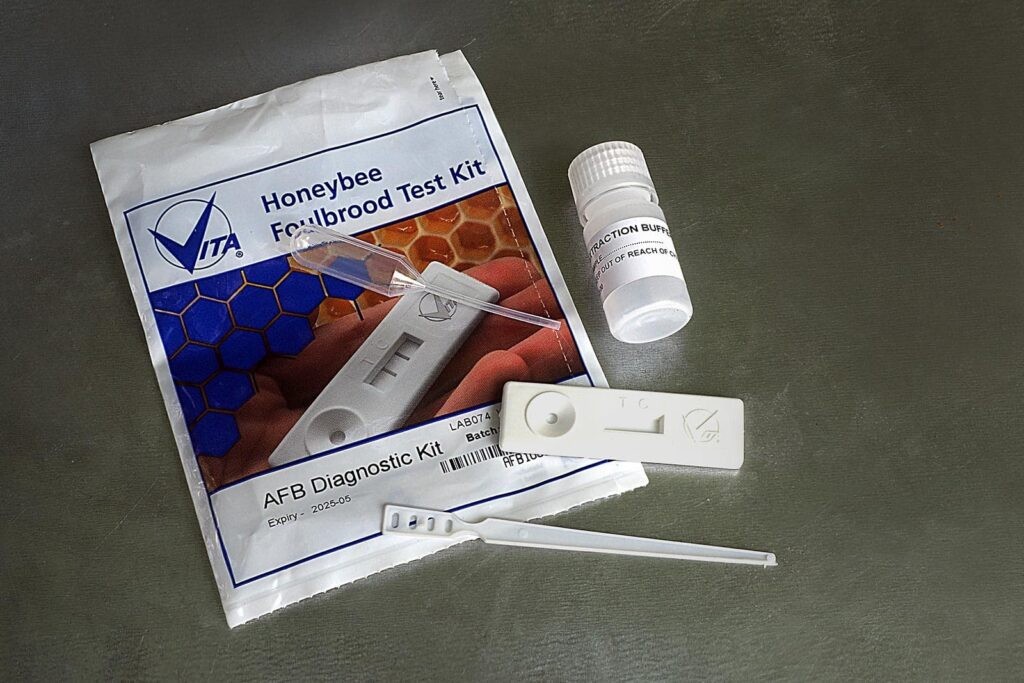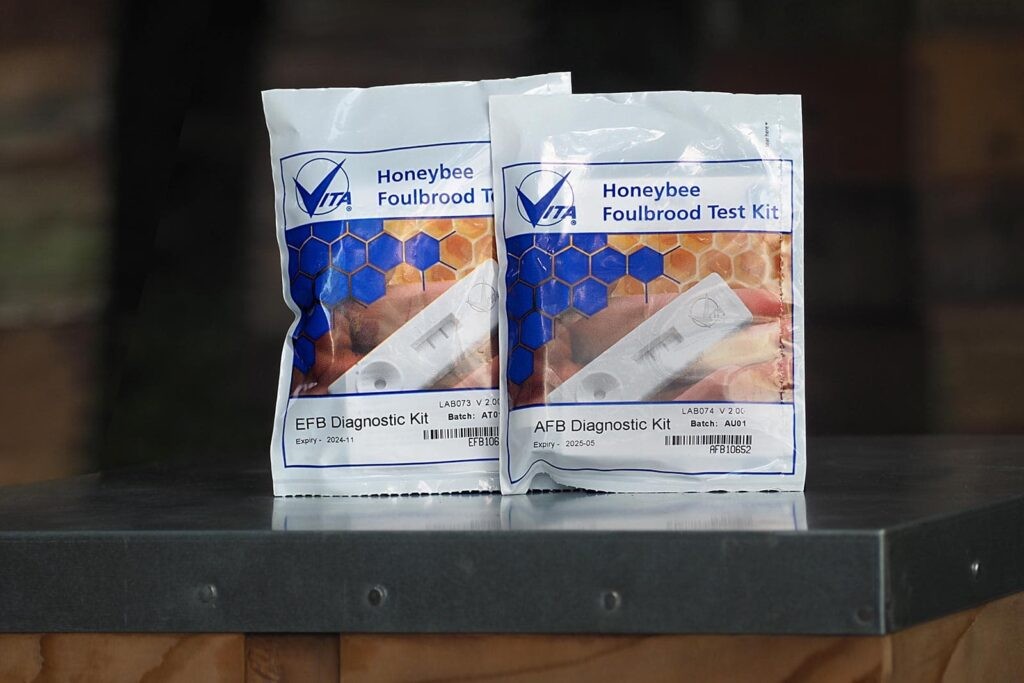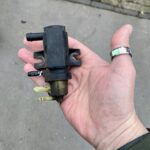American Foulbrood (AFB) is a devastating disease for honeybee colonies, and early detection is crucial for effective management. The Vita American Foulbrood (AFB) Diagnostic Test Kit provides beekeepers and bee inspectors with a fast, reliable, and user-friendly solution to identify AFB infections directly in the apiary. This innovative Diagnostic Kit allows for immediate results, similar to a home pregnancy or COVID-19 test, empowering beekeepers to take swift action to protect their hives.
Key Advantages of the AFB Diagnostic Kit
This diagnostic kit is designed for ease of use and rapid results, making it an indispensable tool for proactive bee health management. Here are some key features:
- Immediate Results: Obtain clear results within minutes, enabling quick decision-making in the field.
- Specific Detection: The kit specifically targets antibodies associated with Paenibacillus larvae subsp. larvae, the bacterium responsible for American Foulbrood in honeybees, ensuring accurate diagnosis.
- User-Friendly: Simple to use, requiring no specialized laboratory equipment or expertise. The process is similar to familiar rapid tests, making it accessible for all beekeepers.
- On-Site Testing: Perform tests directly in your apiary, eliminating the need to send samples to a lab and wait for results.
How to Effectively Use the AFB Diagnostic Kit
Follow these straightforward steps to conduct a test using the AFB diagnostic kit:
- Sample Collection: Carefully extract a honeybee larva exhibiting suspicious symptoms using the provided spatula. You can sample multiple larvae or scales if necessary. It’s crucial to use only a small amount of organic material to avoid clogging the device. Tiny samples are sufficient for accurate testing.
- Sample Preparation: Unscrew the lid of the Extraction Bottle and deposit the collected sample into the bottle using the spatula. Securely replace the lid and shake the bottle vigorously for approximately 20 seconds to ensure proper mixing.
- Device Preparation: Remove a Test Device from its protective foil pack. Important: Avoid touching the viewing window of the test device to maintain test integrity.
- Sample Application: Unscrew the lid of the Extraction Bottle again. Using the provided pipette, carefully draw a sample from the bottle. For optimal results, extract the sample immediately after shaking to prevent bacterial settling.
- Testing: Hold the Test Device horizontally and gently dispense two drops of the extracted sample onto the designated sample well of the device.
- Absorption and Dye Appearance: Maintain the device in a horizontal position and wait for the extract to be fully absorbed (approximately 30 seconds). You will observe a blue dye appearing in the viewing window as the sample moves through the test strip.
- Result Interpretation: Allow the test to develop for 3 to 10 minutes until the control line (marked ‘C’) becomes visible. Then, read and interpret the result as explained in the “Reading the Results” section below.
Kit Contents: Everything You Need for On-Site Diagnosis
The AFB diagnostic kit is thoughtfully assembled to provide all the necessary components for conducting tests in the field. It is designed to work independently or as a complementary tool to the EFB Diagnostic Kit for comprehensive bee disease monitoring.
While whole or partial larval samples can be used, using a whole infected larva is recommended to maximize test sensitivity and accuracy. This diagnostic kit delivers performance comparable to standard laboratory AFB tests. Its reliability has been rigorously validated by the National Bee Unit of the Food and Environment Research Agency (FERA) in York, UK, and other reputable international institutions. The kit was developed in collaboration with the Foresight Diagnostics section at FERA, York, UK, for Vita Bee Health.
Understanding Your Diagnostic Kit Results
Interpreting the results from the AFB diagnostic kit is straightforward:
- Positive Result (AFB Detected): If two blue lines appear in the viewing window – both at the Test line (T) and the Control line (C) – this indicates a positive result. The target pathogen, Paenibacillus larvae, is present in the sample, confirming an American Foulbrood infection.
- Negative Result (AFB Not Detected): If only one blue line appears at the Control line (C) and no line appears at the Test line (T), this indicates a negative result. The AFB pathogen was not detected in the tested sample.
Result Validity and Troubleshooting:
- Valid Positive Result: Two blue lines (C & T). Test performed correctly.
- Valid Negative Result: One blue line (C only). Test performed correctly.
- Possible Positive Result: Faint blue T line, strong C line. Test performed correctly, consider retesting.
- Invalid Test: One blue line (T only) – Test failed. Repeat the test.
- Invalid Test: No lines present – Test failed. Repeat the test.
- Invalid Test: Brown C or T lines – Test failed. Repeat the test with a smaller sample.
In case of a failed test, it is recommended to perform a new test using a fresh sample from the same comb and a new device. If problems persist, please contact Vita (Europe) Limited for assistance, quoting the batch number found on the device’s reverse label.
Important Note: As with any diagnostic test, a negative result does not definitively rule out the presence of the pathogen. A faint or absent test line may occur with low pathogen concentrations or very recent infections. If you remain uncertain, repeat the test with a new device and a fresh sample or re-test after a few days.
Kit Storage, Handling, and Safety Information
To ensure optimal performance and longevity of your AFB diagnostic kit, please adhere to these guidelines:
- Single Use and Disposal: Kits are for single use only and should be disposed of properly after testing.
- Storage Conditions: Store unopened foil packs at room temperature (approximately 18–25°C or 64–77°F) until needed.
- Keep Dry: Devices must be kept dry at all times to maintain their effectiveness.
- Use Promptly After Opening: Once the foil pack is opened, the device’s shelf life is not guaranteed. Use it as soon as possible after opening.
- Avoid Touching the Window: Do not touch the viewing window of the test device.
- Inspect for Damage: If the device appears damaged, scratched, or marked, please contact us for a replacement.
- Read Instructions: Always read all instructions thoroughly before using the diagnostic kit.
- Caution: Toxic Components: The extraction buffer in this kit contains sodium azide, a toxic substance. Handle with care, avoid ingestion and skin contact. Sodium azide can form explosive compounds in plumbing systems. Always dispose of azide-containing materials by flushing with copious amounts of water.
Troubleshooting Common Issues
| Problem | Cause / Remedy |
|---|---|
| Sample not mixed | Inefficient extraction due to sample size (too large or too small) or insufficient shaking. Try a fresh sample, ensure correct sample size, and shake more vigorously. |
| No blue dye flow | Insufficient sample volume. Add an additional drop of sample, one drop at a time, until flow is achieved. |
| No control line visible | Too much sample added, causing the test to flood. Repeat with a new device, adding only two or three drops of sample. Alternatively, flow components may have been exposed to moisture. Repeat with a new device, ensuring dry conditions. |
| Brown lines (not blue) visible | Concentrated sample interfering with pathogen recognition. Repeat with a new, smaller sample. |
| Faint lines | Low pathogen concentration in the sample, possibly due to small sample size, insufficient shaking, or low infection level. |
| Damaged Devices/Bottles | Contact Vita directly, quoting the batch number for reference and replacement. |
| Lines disappear after hours | Degradative enzymes in the sample damaging antibodies. Read test results within 30 minutes of completion only. |
Further Information
For more information on bee health and disease management, and to explore related diagnostic tools, see also Vita’s European Foulbrood (EFB) diagnostic test kit.


